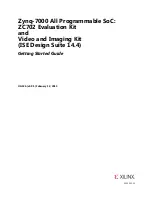
WM Access Domain Services Configuration
Summit WM20 User Guide, Software Release 4.2
138
●
152-bit
6
Select one of the following input methods:
●
Input Hex
– If you select
Input Hex
, type the WEP key input in the
WEP Key
box. The key is
generated automatically, based on the input.
●
Input String
– If you select
Input String
, type the secret WEP key string used for encrypting and
decrypting in the
WEP Key String
box. The WEP Key box is automatically filled by the
corresponding Hex code.
7
To save your changes, click
Save
.
Dynamic WEP Privacy for an AAA WM-AD
The dynamic key WEP mechanism changes the key for each user and each session.
To set up dynamic WEP privacy for a selected AAA WM-AD:
1
From the main menu, click
WM-AD Configuration
. The
WM-AD Configuration
screen is
displayed.
2
In the left pane
WM Access Domains
list, click the AAA WM-AD you want to set up dynamic WEP
privacy for. The
Topology
tab is displayed.
3
Click the
Privacy
tab.
4
Select
Dynamic Keys
.
5
To save your changes, click
Save
.
Wi-Fi Protected Access (WPA v1 and WPA v2) Privacy for an AAA WM-AD
The WM-AD Privacy feature supports Wi-Fi Protected Access (WPA v1 and WPA v2), a security
solution that adds authentication to enhanced WEP encryption and key management.
The authentication portion of WPA for AAA is in Enterprise Mode:
●
Specifies 802.1x with Extensible Authentication Protocol (EAP)
●
Requires a RADIUS or other authentication server
●
Uses RADIUS protocols for authentication and key distribution
●
Centralizes management of user credentials
The encryption portion of WPA v1 is Temporal Key Integrity Protocol (TKIP). TKIP includes:
●
A per-packet key mixing function that shares a starting key between devices, and then changes their
encryption key for every packet (unicast key) or after the specified re-key time interval (broadcast
key) expires
●
An extended WEP key length of 256-bits
●
An enhanced Initialization Vector (IV) of 48 bits, instead of 24 bits, making it more difficult to
compromise
●
A Message Integrity Check or Code (MIC), an additional 8-byte code that is inserted before the
standard WEP 4-byte Integrity Check Value (ICV). These integrity codes are used to calculate and
compare, between sender and receiver, the value of all bits in a message, which ensures that the
message has not been tampered with.
Summary of Contents for Summit WM20
Page 8: ...Table of Contents Summit WM20 User Guide Software Release 4 2 8 ...
Page 20: ...About this Guide Summit WM20 User Guide Software Release 4 2 20 ...
Page 54: ...Configuring the Summit WM Controller Summit WM20 User Guide Software Release 4 2 54 ...
Page 96: ...WM Access Domain Services Summit WM20 User Guide Software Release 4 2 96 ...
Page 150: ...WM Access Domain Services Configuration Summit WM20 User Guide Software Release 4 2 150 ...
Page 168: ...Availability and Controller Functionality Summit WM20 User Guide Software Release 4 2 168 ...
Page 172: ...Working With Third Party APs Summit WM20 User Guide Software Release 4 2 172 ...
Page 184: ...Working With the Summit WM Series Spy Summit WM20 User Guide Software Release 4 2 184 ...
Page 194: ...Working With Reports and Displays Summit WM20 User Guide Software Release 4 2 194 ...
Page 216: ...Performing System Maintenance Summit WM20 User Guide Software Release 4 2 216 ...
















































